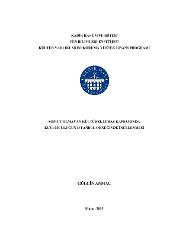| dc.contributor.advisor | Erkan Kösebay, Yonca | en_US |
| dc.contributor.author | Anmaç, Gülçin | |
| dc.date.accessioned | 2019-07-12T08:42:39Z | en_US |
| dc.date.available | 2019-07-12T08:42:39Z | en_US |
| dc.date.issued | 2013 | en_US |
| dc.identifier.uri | https://hdl.handle.net/20.500.12469/2569 | |
| dc.description.abstract | Günümüzün gelenek ustalarının devam ettirdikleri kuyumculuk sanatında, halen kullandıkları tekniklerin özellikleri örnekleri ile açıklanmıstır. Sürdürdükleri üretim süreçleri, İstanbul'da kuyumculuğun merkezi sayılan Kapalıçarsı'da yapılan görsel belgelemeler sonucunda elde edilen örnekler verilerek açıklanmıstır. Bu tespitleri takiben, SOKÜM kapsamında hammaddesi metal olan geleneksel sanatlarımızın devamlılığı için yapılanlar, geleneksel yöntemleri kullanarak maden isleri yapan kuyumcu ustalarının tespiti için gerçeklestirilen belgeleme yöntemleri ve bu yöndeki çesitli uygulamalar incelenerek, tespit edilen bazı noktalarda çesitli önerilerde bulunulmustur. | en_US |
| dc.description.abstract | The concept of cultural heritage has moved to a broader viewpoint with the developing perspectives and Intangible Cultural Heritage has taken on a new significance. Even though the national policies vary by content and emphasis, international organizations and agreements have been effective on reaching the future generations and the society that carves out the culture. In this study, the areas that are considered as Intangible Cultural Heritage within the cultural policy of Republic of Turkey and international foundations and the protections undertaken for intangible cultural heritages are analyzed. The professions and election steps of those who are being recognized as Intangible Cultural Heritage Carriers by the Center of Information and Documentation of Folk Culture, Directorate General for Research and Education in the Ministry of Culture and Tourism are examined. The process steps and stages of implementation and enrollment of inventory studies of Living Human Treasures are examined. The technical specifications and processes of production of the art of jewelry that is carried on by the masters of tradition are explained with samples and visual documentations. Visual documentations belong to the jewelry workshops of Kapalicarsi, Istanbul. Consequently, methods are put forward on what can be done within the scope of Intangible Cultural Heritage for the continuity of traditional arts that use metal as a raw material and suggestions are given to remedy the deficiencies that are examined in methods of determination and documentation of goldsmiths using traditional methods. | en_US |
| dc.language.iso | tur | en_US |
| dc.publisher | Kadir Has Üniversitesi | en_US |
| dc.rights | info:eu-repo/semantics/openAccess | en_US |
| dc.subject | Halk kültürü | en_US |
| dc.subject | Kültür | en_US |
| dc.subject | Kültür varlıkları | en_US |
| dc.subject | Kültürel miras | en_US |
| dc.subject | Madeni takılar | en_US |
| dc.subject | Sosyal antropoloji | en_US |
| dc.subject | Tarihi koruma | en_US |
| dc.subject | Türk el sanatları | en_US |
| dc.subject | Türk kültürü | en_US |
| dc.subject | İstanbul-Kapalıçarşı | en_US |
| dc.subject | Folk culture | en_US |
| dc.subject | Culture | en_US |
| dc.subject | Cultural properties | en_US |
| dc.subject | Cultural heritage | en_US |
| dc.subject | Metal parures | en_US |
| dc.subject | Social anthropology | en_US |
| dc.subject | Historic preservation | en_US |
| dc.subject | Turkish handcrafts | en_US |
| dc.subject | Turkish culture | en_US |
| dc.title | Somut olmayan kültürel miras kapsamında kuyumculuğun İstanbul örneğinde incelenmesi | en_US |
| dc.type | masterThesis | en_US |
| dc.department | Enstitüler, Lisansüstü Eğitim Enstitüsü, Kültür Varlıklarını Koruma Ana Bilim Dalı | en_US |
| dc.relation.publicationcategory | Tez | en_US |
| dc.identifier.yoktezid | 333167 | en_US |
















